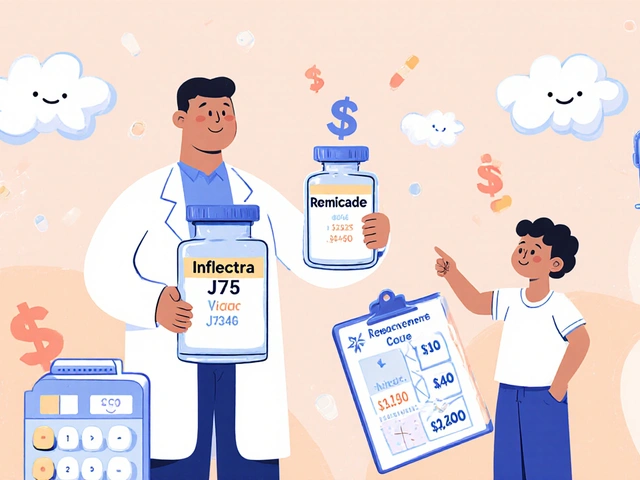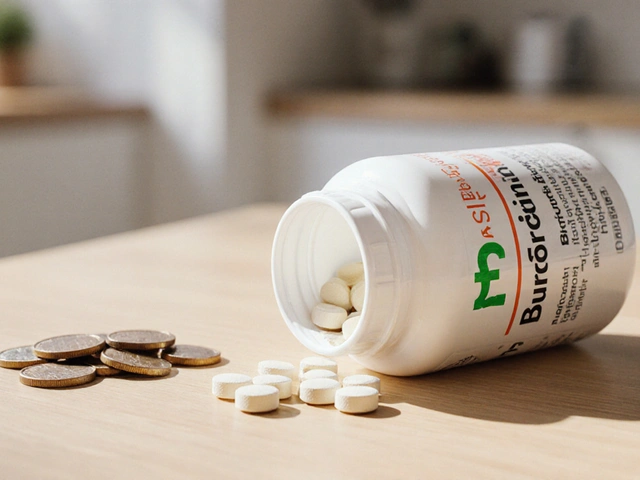Fluticasone‑salmeterol is a combination inhaler that pairs an inhaled corticosteroid (fluticasone) with a long‑acting beta2‑agonist (salmeterol), designed to control persistent asthma and reduce flare‑ups in children aged 4‑11 years.
Quick Takeaways
- Start with fluticasone-salmeterol children dosage of 50µg/25µg per puff, two puffs twice daily for ages 4‑11.
- Always use a spacer or valved holding chamber for optimal lung delivery.
- Monitor growth, oral thrush, and heart rate; report any adverse signs to a paediatrician.
- Never replace a rescue inhaler with this medication; keep a short‑acting bronchodilator on hand.
- Follow national guidelines (GINA) and local prescribing policies for step‑up or step‑down therapy.
Understanding the Core Components
Fluticasone is an inhaled corticosteroid (ICS) that reduces airway inflammation by binding glucocorticoid receptors, lowering cytokine production, and improving airway calibre.
Salmeterol is a long‑acting beta2‑agonist (LABA) that relaxes airway smooth muscle for up to 12 hours, complementing the anti‑inflammatory action of fluticasone.
The synergy means children can stay symptom‑free with fewer daily doses compared to using an ICS alone.
Who Can Use It? Age and Diagnosis Criteria
The FDA approves fluticasone‑salmeterol for children 4‑11 years with persistent asthma, defined as symptoms more than twice a week or night‑time awakenings more than once a month despite low‑dose rescue inhaler use. It is not indicated for acute attacks, COPD, or children under four.
Clinicians often follow the GINA (Global Initiative for Asthma) guidelines to place the child on step3 therapy, where a low‑dose combination inhaler becomes the cornerstone.
Dosage Recommendations and Adjustments
Standard dosing for the 50µg/25µg formulation is:
- Two inhalations (100µg fluticasone/50µg salmeterol) in the morning.
- Two inhalations in the evening, spaced at least 12 hours apart.
For children at the lower end of the age range (4‑5years) or with low body weight (<20kg), a step‑down approach using a half‑dose device (25µg/12.5µg) may be considered under specialist guidance.
Increase or decrease the dose only after assessing:
- Peak flow readings (target ≥80% predicted).
- Frequency of rescue inhaler use (≤2 puffs/week is ideal).
- Any side‑effects such as hoarseness or oral thrush.
Safety Profile: What Parents Should Watch For
The major safety concerns fall into three buckets: local, systemic, and cardiovascular.
Local effects include oral candidiasis and dysphonia. Rinsing the mouth and spacer cleaning after each use cuts the risk by >90% (studies from the British Thoracic Society).
Systemic exposure is low but can affect growth. Long‑term monitoring of height and weight every 6‑12months is recommended, especially if the child stays on high‑dose fluticasone for more than a year.
Cardiovascular signs such as tachycardia, tremor, or palpitations may signal excess LABA activity. These are rare (<0.1% of users) but warrant immediate medical review.
Contra‑indications include hypersensitivity to either component, active respiratory infections, and concomitant use of non‑selective beta‑blockers.
Drug Interactions and Other Medications
While fluticasone‑salmeterol has a relatively clean interaction profile, a few combinations deserve caution:
- Ritonavir can increase systemic fluticasone levels, potentially suppressing the hypothalamic‑pituitary‑adrenal axis.
- Theophylline may amplify LABA‑related tachycardia if high plasma concentrations coexist.
- Concurrent use of monoclonal antibodies (e.g., omalizumab) does not require dose change but clinicians should verify that the child's overall asthma control plan remains coherent.

Practical Administration Tips
Correct technique makes the difference between a well‑controlled child and persistent wheeze.
- Attach a spacer or valved holding chamber to the inhaler; this reduces oropharyngeal deposition by up to 80%.
- Shake the inhaler for at least 5seconds before each use.
- Have the child exhale fully, place the mouthpiece, and inhale slowly and deeply, then hold breath for 10 seconds.
- Rinse mouth with water (no need to swallow) after each session.
- Store the inhaler at room temperature, away from direct heat; replace after 12months from opening, even if doses remain.
Comparing Common Pediatric Asthma Inhalers
| Inhaler | Active ingredients | Typical dose (4‑11yr) | Primary use | Key safety notes |
|---|---|---|---|---|
| Fluticasone‑salmeterol | Fluticasone 50µg + Salmeterol 25µg | 2 puffs BID | Step‑3 controller | Monitor growth, rinse mouth |
| Fluticasone propionate (monotherapy) | Fluticasone 100µg | 1‑2 puffs BID | Step‑2 controller | Lower LABA risk, still watch for thrush |
| Salmeterol (LABA alone) | Salmeterol 50µg | 2 puffs BID | Adjunct to ICS only | Not for monotherapy in children |
The combination inhaler offers convenience-one device delivers both anti‑inflammatory and bronchodilator effects-yet the decision to step up to fluticasone‑salmeterol should consider adherence, side‑effect profile, and the child's severity score.
Related Concepts and Next Steps
Understanding fluticasone‑salmeterol fits into a broader asthma‑management ecosystem. Key related topics include:
- Peak flow monitoring - objective measure to gauge control.
- Asthma action plan - written guide for rescue vs. maintenance steps.
- Allergen avoidance strategies - essential for minimizing triggers.
- Vaccination recommendations - especially influenza and COVID‑19 for high‑risk kids.
- Spirometry - periodic lung function testing to adjust therapy.
After mastering dosage and safety, parents often ask about stepping down once control is achieved. The typical pathway is to halve the dose for a month, then revert to a low‑dose inhaled corticosteroid alone, always under a clinician’s supervision.
Common Pitfalls and How to Avoid Them
Even seasoned parents slip into habits that reduce efficacy:
- Skipping the spacer: Direct inhalation deposits more drug in the mouth, raising thrush risk.
- Using the inhaler during an acute attack: LABA needs several doses to build effect; rely on a rescue inhaler instead.
- Not tracking usage: A simple diary or app helps spot over‑use (a red flag for uncontrolled asthma).
- Sharing inhalers: Different dosing and infection control make this unsafe.
When to Seek Professional Help
If any of the following occur, contact a paediatrician or asthma nurse promptly:
- Repeated nighttime cough or wheeze despite adherence.
- Noticeable drop in height percentile over two consecutive visits.
- Oral thrush that does not clear after rinsing and proper technique.
- Unexplained rapid heart rate or tremor after inhaler use.
- Any allergic reaction - rash, swelling, or breathing difficulty.
Early intervention prevents escalation to oral corticosteroids or emergency department visits.
Frequently Asked Questions
Can a child use fluticasone‑salmeterol if they have a cold?
A mild cold doesn’t usually require stopping the inhaler. In fact, maintaining anti‑inflammatory therapy helps prevent the cold from worsening asthma. However, if the child develops a fever >38°C or severe sinus congestion, review the plan with a clinician.
Is it safe to use the inhaler with a metered‑dose spacer for a 5‑year‑old?
Yes. A spacer is actually recommended for children under 12. It ensures more medication reaches the lungs and reduces oral side‑effects. Choose a child‑size mask and clean it weekly.
How long does it take to see improvement after starting fluticasone‑salmeterol?
Most children notice fewer night‑time symptoms within 2‑3weeks. Full anti‑inflammatory effect may take up to 6weeks, so keep using the inhaler as prescribed even if symptoms persist early on.
What should I do if my child forgets a dose?
If it’s within an hour of the missed dose, give it right away. If it’s closer to the next scheduled dose, skip the missed one and resume the regular schedule-don’t double up.
Can fluticasone‑salmeterol cause growth suppression?
Systemic exposure is low, but long‑term high‑dose use can modestly slow growth (average 0.5‑1cm per year). Regular height checks and using the lowest effective dose mitigate this risk.
Is there an alternative for children who can’t tolerate the inhaler?
Options include a dry‑powder inhaler with fluticasone alone, or once‑daily budesonide/formoterol for kids over 6years. Discuss alternatives with the asthma specialist.






10 Comments
i used this for my 6yo and honestly? it took like 3 weeks to notice anything. i thought it wasn't working, but the doc said to keep going. now he sleeps through the night and doesn't need albuterol every other day. 🙌
OMG I'm so glad someone finally said this-this inhaler is a GAME CHANGER. My kid was in the ER three times last winter. Now? Zero visits. Also, the spacer with the cute dinosaur mask? Worth every penny. 💖
Wait, so you're telling me you're giving your kid a steroid? Like... actual steroids? I thought those were for bodybuilders or something? Are you sure this isn't gonna make him grow hair on his chest or something? 😅
While the clinical data supports the use of fluticasone-salmeterol in pediatric populations per GINA guidelines, it is imperative to note that systemic bioavailability, though low, may still exert measurable effects on the hypothalamic-pituitary-adrenal axis. Longitudinal growth monitoring remains non-negotiable, particularly in children receiving daily dosing beyond 12 months. The risk-benefit calculus must be reassessed quarterly, not annually.
Thank you for the detailed post. I appreciate the emphasis on spacer use and growth monitoring. Many parents overlook the importance of rinsing after use-oral thrush is far more common than people realize. A simple water rinse can prevent a lot of unnecessary visits to the pediatrician.
Ugh I’m so tired of people being scared of steroids. 🤦♀️ My daughter’s been on this for 2 years and she’s taller than half her class. Growth suppression? More like growth BOOST. 🚀 #AsthmaWarrior #NoFear
Hey, just wanted to say-YOU’RE DOING AMAZING. If you’re reading this and you’re a parent managing asthma, you’re a superhero. 💪 This stuff works. Don’t give up. And yes, the spacer is your new BFF. Trust me.
As a pediatric nurse in rural Texas, I’ve seen kids go from barely breathing to running track after starting this combo. The key? Consistency. And yes, spacers. Always spacers. Even if your kid thinks they’re silly. 🤫❤️
It’s fascinating how such a simple device-a plastic tube with a mask-can transform a child’s life. The physics of aerosol delivery is quietly revolutionary. I’ve watched toddlers who couldn’t climb stairs become kids who race their siblings down the driveway. It’s not magic. It’s medicine. And it’s beautiful. 🌿
Look, I don't care what the 'guidelines' say-this is just another way the medical-industrial complex is drugging our kids. I don't trust big pharma. My kid’s asthma is fine with honey and breathing exercises. 🇺🇸 #AmericaFirstHealth